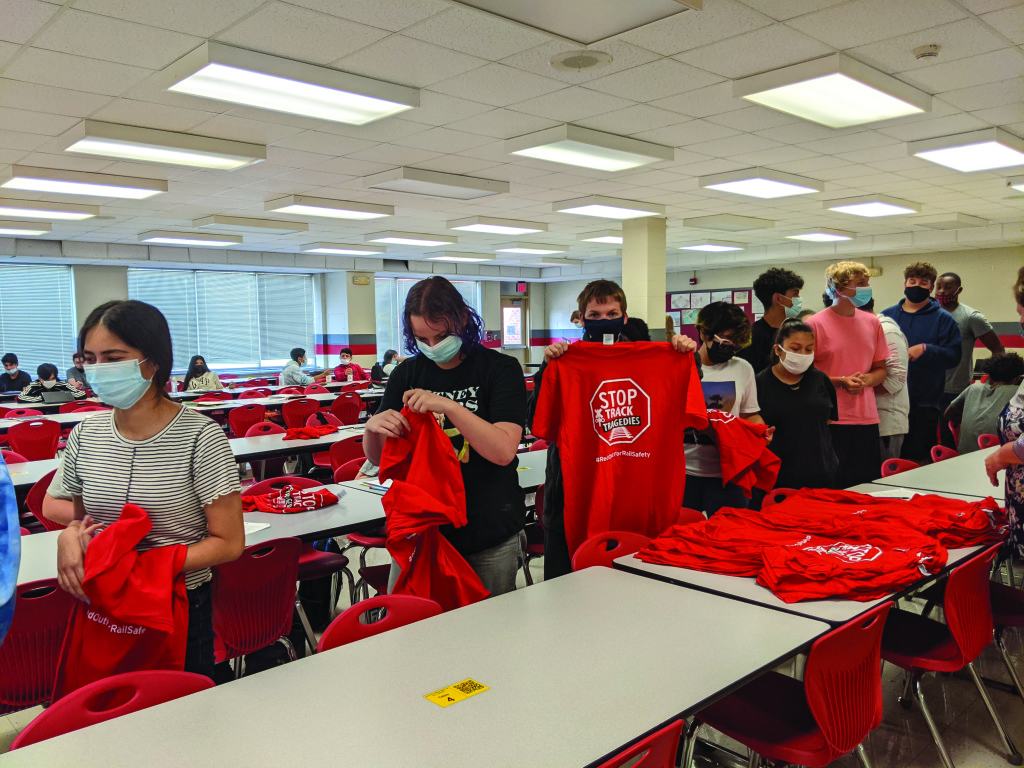 Each year, 2,000 people are tragically injured or killed in railway crossing and trespassing incidents across the U.S. In North Carolina last year, there were 34 crossing crashes, resulting in six fatalities and eight injuries. Additionally, 20 known incidents of people walking on tracks resulted in 11 fatalities and six injuries, according to the N.C. Department of Transportation.
Each year, 2,000 people are tragically injured or killed in railway crossing and trespassing incidents across the U.S. In North Carolina last year, there were 34 crossing crashes, resulting in six fatalities and eight injuries. Additionally, 20 known incidents of people walking on tracks resulted in 11 fatalities and six injuries, according to the N.C. Department of Transportation.
“On average, every three hours in the United States, someone has a dangerous or deadly encounter with a train as an operator of an automobile at a railroad crossing or as an unaware pedestrian walking on the tracks,” said Jahmal Pullen, engineering coordination and safety manager for NCDOT’s Rail Division.
A Collective Effort
Operation Lifesaver Inc., Operation Lifesaver Canada and the Mexican Association of Railroads have joined forces to promote rail safety across North America by observing Rail Safety Week September 19-25. The annual crusade spotlights safe practices when around railroad property in an effort to #STOPTrackTragedies. Through virtual and face-to-face outreach, Rail Safety Week is celebrated through an awareness campaign, local events and safety tips for distribution to pedestrians, drivers, transit riders and passenger rail users.
Operation Lifesaver (OL) and its member organizations in 46 states actively pursue a goal of reducing collisions, fatalities and injuries at crossings and trespassing on or near railroad tracks. OL was founded in 1972, when “around 12,000 people were killed or injured by trains every year in the U.S.,” said Margaret Cannell, state coordinator of North Carolina Operation Lifesaver. “In the 50 years since OL was founded, the number of incidents has decreased to around 2,000 fatalities and injuries in highway/rail collisions and trespassing strikes. While that is progress, North Carolinians continue to have collisions and trespassing incidents.”
North Carolina is currently ranked 12th highest in the nation in trespassing events. “An overwhelming number of people do not know that all railroad property is private property and, without the consent of the railroad, it is dangerous, deadly and illegal to be on or near the tracks,” Pullen said. Walking on railroad tracks or railroad property is a Class 3 misdemeanor, punishable by a fine of up to $350, and is a violation of NC General Statute 14-280.1.
To increase rail safety awareness among law enforcement officers and the public, the Amtrak Police Department leads Operation Clear Track, which takes place during Rail Safety Week. Operation Clear Track is the largest law-enforcement initiative for rail safety in North America in which police departments work together to enforce rail crossing and trespassing laws to help reduce the number of railway crossing and trespassing incidents.
“Amtrak is a wonderful partner for North Carolina Operation Lifesaver and law enforcement is very involved in Operation Clear Track. In 2021, North Carolina had almost three times the law enforcement participation of any other state, with 65 law enforcement and first responder agencies participating live, virtually, and via social media,” Cannell said.
NCDOT also assists North Carolina Operation Lifesaver through its statewide safety initiative, BeRailSafe, which educates children and adults about the dangers of being on and around railroad tracks. BeRailSafe performs follow-up investigations of North Carolina rail-related incidents and evaluates measures and strategies to prevent and deter future motor vehicle and pedestrian incidents. It also champions research in cooperation with universities throughout the state in the areas of highway-rail grade crossing and pedestrian trespass matters to better understand the problem and incorporate statewide mitigation strategies.
Look, Listen and Live: Lifesaving Tips
Operation Lifesaver and the NCDOT Rail Division share these tips for drivers, pedestrians and cyclists:
Never stop a car on the railroad tracks. If you stop to wait for a train at a traffic signal, always stop safely behind the white line.
Always stop your vehicle when the crossing gates are down or lights are flashing. Never drive around the gate or race a train to the crossing.
Trains always have the right-of-way, even when emergency and law enforcement vehicles are involved.
It is hard to determine a train’s speed from a distance. The train you see is closer and moving faster than it seems.
It can take a train traveling 55 miles per hour a mile or more to come to a stop. Longer trains take longer to stop.
Trains can run on any track, at any time, in either direction. At a multiple track crossing waiting for a train to pass, watch out for a second train on the other tracks, approaching from either direction.
Freight trains don’t travel at fixed times, and schedules for passenger trains often change. Expect a train at each railroad intersection at any time.
Avoid distracted driving. Distraction leads to danger as multitasking drivers fail to notice that they are approaching railroad crossings.
By federal law, every railroad crossing has to have a blue 9” x 13” Emergency Notification System sign that shows the name of the railroad that owns/runs that track, an 800-number to contact the railroad company, and a DOT crossing number that is unique to that crossing. In the event of an emergency, such as a stalled vehicle on the tracks, the first thing to do is to get out of the vehicle and get away from the tracks. Look for the sign and call the 800-number to report the emergency. The responding railroad employee can contact the engineer on an approaching train and ask them to slow down or stop to avoid a collision. Again, if your vehicle ever stalls on the tracks, get out and get away from the tracks, even if you do not see a train. Locate the Emergency Notification System sign and call the number provided, telling them about the stalled vehicle.
Never walk or ride a bike on or near the railroad tracks. Tracks are not a shortcut.
Train tracks are not a playground, photo studio, walking path or recreation area. Train tracks are private property, and crossing at unmarked areas or walking on the tracks is dangerous and a criminal offense. Remember to cross train tracks only at designated pedestrian or roadway crossings, and obey all warning signs and signals posted there.
You may not always see, feel or hear a train approaching. Today’s trains are longer, faster and quieter than ever before – producing no telltale “clackety-clack” – and can sneak up on you, especially if you are wearing earphones, are on your phone or are otherwise distracted.
Trains typically overhang the track by several feet. If you are in the right-of-way next to the tracks, you can be hit.
Keep your pets safe by making sure they stay off the tracks.
Never assume railroad tracks are abandoned or inactive, even if there are weeds or the track looks unused.
Every collision at a railroad crossing and on the tracks is preventable. Stay alert and take care around the rail.
North Carolina Operation Lifesaver needs volunteers of all ages to promote rail safety. Volunteers go through a training program to become Operation Lifesaver Authorized Volunteers (OLAVs) and are provided with approved materials such as videos, brochures, handouts and books to distribute while manning booths at fairs and events, or when making presentations. Find out more at oli.org/safety-near-trains/volunteer.
Learn more about Rail Safety Week at oli.org, berailsafe.org, facebook.com/ApexPolice and #STOPTrackTragedies.







